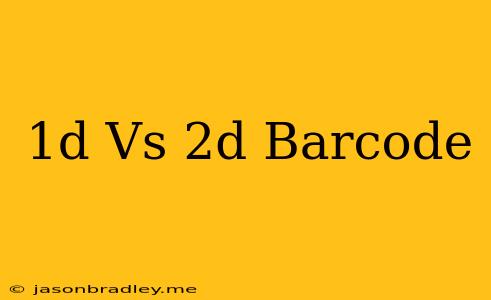Oke, berikut adalah artikel tentang kode batang 1D vs kode batang 2D:
1D vs 2D Barcodes: What's the Difference?
Barcodes have become an integral part of our lives, silently facilitating everything from grocery store checkout to tracking inventory in warehouses. While we might not give them much thought, there's a distinct difference between the traditional 1D barcodes we see on most products and the increasingly popular 2D barcodes.
1D Barcodes: The Basics
1D barcodes, also known as linear barcodes, are the classic black-and-white stripes you're likely familiar with. They store information in a single dimension, using a combination of varying widths of bars and spaces to represent data.
Strengths of 1D Barcodes:
- Simplicity: 1D barcodes are relatively easy to create and read.
- Widely Compatible: Most barcode scanners can read 1D barcodes.
- Cost-Effective: They are generally cheaper to print than 2D barcodes.
Limitations of 1D Barcodes:
- Limited Storage: They can only store a small amount of data (typically up to 20 characters).
- Vulnerable to Damage: A small tear or smudge can render the barcode unreadable.
- Difficult to Encode Specific Information: They can't represent complex data like images or URLs.
2D Barcodes: The Future of Data Encoding
2D barcodes, on the other hand, have revolutionized data storage. They use a matrix of squares (like a QR code) to store information in two dimensions. This allows them to hold significantly more data than 1D barcodes.
Strengths of 2D Barcodes:
- High Storage Capacity: They can encode thousands of characters, including text, numbers, URLs, and even images.
- Error Correction: They are more resilient to damage, with built-in error correction capabilities.
- Versatile: They can be used for a wide range of applications, from product identification to mobile payments.
Limitations of 2D Barcodes:
- More Complex: They require specialized scanners for reading.
- Potentially More Expensive: 2D barcodes can be more expensive to print than 1D barcodes.
When to Choose Which Barcode Type
The best choice between 1D and 2D barcodes depends on your specific needs:
- For basic product identification and tracking: 1D barcodes are perfectly sufficient.
- For storing large amounts of data, complex information, or providing interactive content: 2D barcodes are the better option.
Ultimately, the choice depends on the specific requirements of your application. However, with their ability to store more data and offer greater resilience, 2D barcodes are increasingly becoming the preferred choice in many industries.
